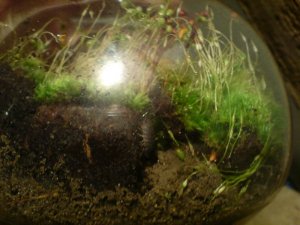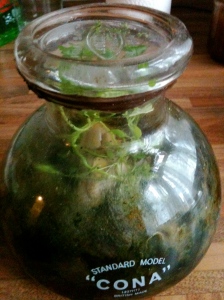Three years ago I made a DIY ecosphere. This involves selecting various living organisms, sealing them up in an entirely self-contained system, and seeing how they get on. Only light can get in.
The inspiration for the idea was here and here.
In my case, the system included the following components:
- coffee jug
- glass lid
- bathroom sealant
- handful of gravel
- handful of soil
- moss and attached peat
- large decorative stone (flint)
- liverwort
- flowering plant seeds
- some woodlice
- small centipede
- numerous microorganisms
This is what happened next, with pictures.
Day 0:

Placed in well-illuminated room, out of direct sunlight.
Day 1:

No real change. Woodlice scurrying happily. Spot the centipede.
Day 3:

A few subtle changes: 2-3 woodlice seen- docile but still moving; condensation on glass; edges of liverwort going brown; moss looks healthy.
Day 5:

The centipede and all the visible woodlice are dead. A few small thread-like creatures are active on the sides of the glass.
Day 8:

It’s apocalypse for all multicellular animals. Nothing moving in there. The liverwort looks very unhappy indeed, and even the moss is starting to yellow. Condensation covering the inside of the glass.
A photo taken at 1 month looks almost exactly the same, but browner: multicellular plant life is also failing the test.
Another month or so later and a few strands of mould became visible in the dead moss, although it never dominated the jug, and indeed died out in turn in the following weeks. So fungus couldn’t cope either.
At this point it seemed clear that I’d killed everything. Chastened, I considered cracking open the jug and repeating the experiment with a seawater-based closed ecosystem, but real world concerns intervened. I ended up just leaving the jug and its brown contents intact in a corner in the spare room.
Perhaps a year or so later, I looked in again. Life! Blue-green slime lined the inside of the glass below soil level, with a thin membrane struggling up towards the still-firmly sealed lid. Not exciting enough for a photograph though.
Interesting. So I hadn’t quite killed everything- just set the coffee jug’s ecology back 2.5 billion years, killing off the eukaryotes and leaving cyanobacteria as the most advanced form of life. I speculated: presumably there’d been an excess of respiring organisms in the initial mix- too many woodlice and soil bacteria, draining the atmosphere of oxygen so effectively that the photosynthesising higher plants were unable to replace it, not even to sustain their own essential oxygen-dependent respiratory pathways.
Another year or so, and no obvious change— still looking positively Proterozoic in there.
Then, the big surprise.
Month 30:

A flowering plant.
And to bring it up to date—
Month 36:


Taken a week ago, and how it looks now.
The eukaryotes are definitely back. The cyanobacteria presumably did for the coffee jug exactly what they did for the early Earth: gradually increase levels of oxygen in the atmosphere until conditions were suitable for ‘higher’ life to exist. On the early Earth, of course, there were no seeds in the soil waiting for suitable conditions to germinate: the new structures and metabolic pathways had to evolve spontaneously over multiple generations.
It would have been great to have been able to monitor atmospheric composition in the jug directly, but I’ll admit that the story of the first few weeks isn’t entirely guesswork: an Open University experiment followed a similar path, with die-offs and changes in CO2 and O2 levels as described above for the first four weeks. But it’s the inferred slow changes that occurred in the following months and years which were so unexpected and interesting. The seal, by the way, is still very much intact.
What’s sobering is how quickly the carbon dioxide catastrophe occurred, and how long the recovery period took: five days to kill all complex multicellular animal life, multicellular plant life lasting weeks, and mould succumbing within months. Then two and a half years to get the biocomplexity back again (and that’s with seeds).
I could have spent £90+ on one of those commercial ecospheres with a stable hawaiian red shrimp-algae-bacteria ecosystem, but I reckon Mossworld teaches a deeper lesson.
Leave a comment